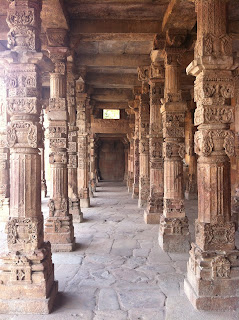There isn't much I can say about the landmarks I saw other than they have a history that I didn't pay much attention to. I was more interested in the intricate stone carving and enormity of some of the structures. You can see what I mean in some of the pictures below.
To the left is the Lotus Temple. It is called such because of it's resemblance to a Lotus flower. It serves as a place of worship for people of all religions. It has received numerous art and architecture awards since it was built in 1986.
After seeing the Lotus Temple, we were on our way to see Old Delhi and I snapped the picture below. The man had 5 propane tanks strapped to his pedal bike. I actually saw this a few times in my short stay here.
 In Old Delhi, there are few major landmarks. One is the Jama Masjid which is the largest and best-known mosque in India. It sits at the top of a hill which has a very narrow road and only bike-rickshaws are allowed up. Cars must be parked at the base of the hill. The bike-rickshaw driver has a tough job going up the hill as he can have up to 3 people on the back while pedaling all the way to the top. The narrow street was lined with street vendors and various shops.
In Old Delhi, there are few major landmarks. One is the Jama Masjid which is the largest and best-known mosque in India. It sits at the top of a hill which has a very narrow road and only bike-rickshaws are allowed up. Cars must be parked at the base of the hill. The bike-rickshaw driver has a tough job going up the hill as he can have up to 3 people on the back while pedaling all the way to the top. The narrow street was lined with street vendors and various shops.

Once we got to the top of the hill to enter the mosque courtyard, I heard an all-to-familiar sound over the loudspeaker. Again, I happened to arrive just as the Muslim prayer was beginning. So I waited for almost a half an hour until I could enter the mosque. There is still a large Muslim population in India to follow these prayer times, although it's not near as large as it is in Saudi.
We went back down to see the Red Fort which sits at the base of the hill. Its perimeter walls are close to 2.5 km in length. I only saw the outside but that was impressive enough. The walls were so massive and strong that it was hard to believe it was constructed without modern technology. Some pictures are below.



The next morning I went to see Qutub Minar which is the tallest minaret in India at 72.5 meters. Minarets are a distinct feature of Islamic mosques and historically, its main function is to provide a point where the call to prayer can be made. Today, I think it mainly serves as a visual feature for the Islamic community, since most of the calls to prayer are done through loudspeaker. The complex around the minaret has various tombs and monuments for many past Indian rulers. Most of these monuments have very intricate carvings covering every surface of the stone. It was very impressive to see. Some pictures are below.


Following the Qutub Minar complex, I went to see the Tomb of Humayun. Not sure who Humayun is or what his significance was but his tomb was there and the architecture was incredible (see below). There was a lot to see here and I'm glad I took the trip to Delhi.

